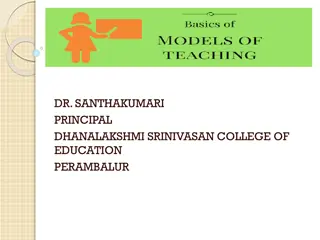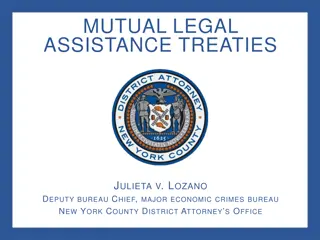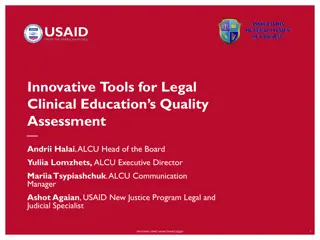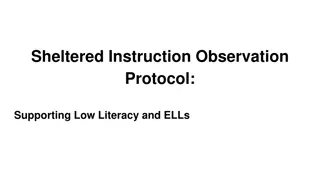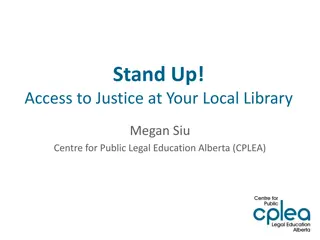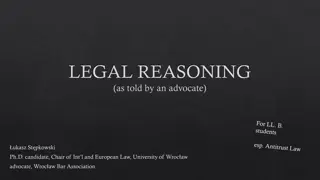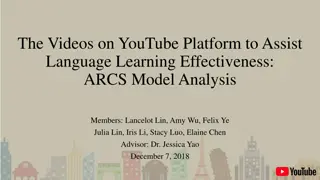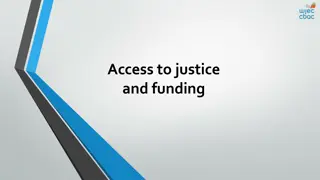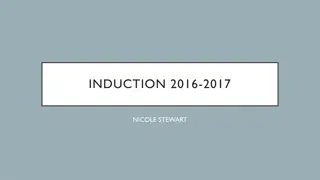
Facilitating Legal English Teaching with SIOP Model
Explore how the SIOP Model can enhance Legal English Teaching, addressing the challenges faced in teaching legal terminology and systems. Discover the benefits of this instructional approach for non-native English speakers and the framework it provides for effective lesson planning.
Download Presentation

Please find below an Image/Link to download the presentation.
The content on the website is provided AS IS for your information and personal use only. It may not be sold, licensed, or shared on other websites without obtaining consent from the author. If you encounter any issues during the download, it is possible that the publisher has removed the file from their server.
You are allowed to download the files provided on this website for personal or commercial use, subject to the condition that they are used lawfully. All files are the property of their respective owners.
The content on the website is provided AS IS for your information and personal use only. It may not be sold, licensed, or shared on other websites without obtaining consent from the author.
E N D
Presentation Transcript
Facilitating Legal English Teaching and Learning through the SIOP Model Veronika Kareva Besa Bytyqi 5thInternational ESP/LSP Conference Sept. 22-23, 2022 Nish, Serbia
Objectives Overview the main challenges of teaching Legal English (LE) Present the SIOP Model (Sheltered Instruction Observation Protocol)as an instructional approach for lesson planning and delivery for making content in English more comprehensible with non-native English speakers Propose a model for teaching LE based on the SIOP principles Discuss its benefits for learning progress
Why teaching/learning Legal English is more complicated than other ESPs? Specificity of legal terminology Legal professionals use a very specialized language even in their mother tongue Differences among legal systems in the countries Students lack of knowledge from the legal field English teachers lack of professional knowledge
Possible solution Framework needed for teachers to use practices that will help LE students to learn both content and English The SIOP Model created in the United States after a 7 year research (1996-2003) by a group of educational experts to present curricular content concepts to second language learners through strategies and techniques that make new information comprehensible In parallel with content presentations, the Model enables teachers to develop students academic language skills in all four domains: reading, writing, listening and speaking
Basic SIOP principles of lesson organization Inclusion of both content and language objectives for every lesson Careful lesson planning including key vocabulary and lesson sequence, based on SIOP features: -motivation through building background -presentation -practice/application and -review/assessment
Methodological approach 1. A questionnaire with students (40 participants attending two levels of Legal English) 2. Experimental lesson created according to the template provided by the authors of the Model 3. Reflections by students after the model lesson
Findings an example question The aim of the questionnaire was to identify the most challenging areas from the LE course for students: Q 1: What is the most challenging for you related to the course Legal English? 0% 0% 0% 5% 5% Learn the new words Understand the text Speak fluently Write well Deal with professional legal content 90% Other
Lesson plan for the topic International Law Content objectives To become familiar with the core of international law and what it regulates To be able to define the term treaty from legal point of view To differentiate between matters governed by EU law and International Law To become familiar with the differences between international law and national law Language objectives To identify the characteristics of the formal legal language To revise the passive constructions Key vocabulary: bound, treaty, party, encompass, sue, dispute, customary, usurp, invariably, sovereignty
Step 1: MOTIVATION: (building background) 10 min. Setting: During the Olympic Games in Peking, one water polo representation claims that the other players took doping and start a case. Which organ will deal with it? Or Which court (organ) prosecuted Slobodan Milosevic? Under which law? Or Turkish military planes fly over the Greek sky without permission? What can happen?
Step 2: PRESENTATION: (language and content objectives, comprehensible input, strategies, interaction, feedback) 20 min. 1. The text, The Scope and Nature of International Law adapted from the book International Law by Vaughan Lowe posted on GC for home reading 2. In class power point presentation 3. Pair work: Question/ answer session Questions: What does the international law regulate? List some international organizations! Which law regulates the dealings of EU member states and which law regulates their dealings with non-member states? What is a human right treaty? Can an individual sue his/her state at the European Court of Justice? What are the differences between international law and national law?
Step 3: PRACTICE/APPLICATION: (meaningful activities, interaction, strategies, practice/application, feedback) 10 min. Group work: Come up with own examples of cases that will be regulated by international law
Lesson ends Step 4. REVIEW/ASSESSMENT: (review objectives and vocabulary, assess learning) 5 to10 min. Step 5. EXTENSION: Homework: Instructions: Search the Internet and report on one case regulated by some international court using formal language
Students reflections Aimed at making students reflect on the experience with the SIOP based lesson compared to the other classes from the LE course conducted in a more traditional way Students guided what to focus on and assigned points for the activity in order to be motivated to complete it 32 completed papers turned in
Conclusions According to students reflections, the SIOP based lesson has managed to solve the biggest issue related to the content in English: it was easier to understand and more convenient to use the new legal terminology; the lesson was perceived as more interesting than regular lessons which lead to higher motivation (asking and answering questions in pairs was fun); they were able to recognize the formal language used in the text; stated that they would like to have more lessons like that one
Limitations of the study Only one lesson demonstrated Conclusions based on students perceptions and not on any performance measure (quiz, test, essay etc.)
Recommendations LE teachers should focus on careful lesson planning Materials should be selected to contain content and language objectives As much as possible, practice flipping the classroom For every lesson, identify the key vocabulary and revise it frequently Try to match the LE syllabus with the study of professional courses: include only the modules that students are dealing with in their professional courses Take examples for discussion from current, actual settings in order to promote critical thinking and increase relevance


